USS Barnegat (AVP-10)
In Puget Sound, Washington, on 14 October 1941 in her original configuration. The class was designed with a large seaplane handling crane, similar to those on the large seaplane tenders, with a clear fantail upon which the aircraft could be serviced. Biscayne (AVP-11) was also completed with this crane and Casco (AVP-12) and Mackinac (AVP-13) were being built with it as of early October 1941.
Photo No. 19-N-26458
Source: U.S. Naval History and Heritage Command
|
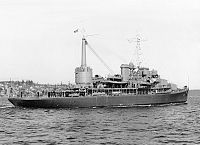 |
USS Biscayne (AVP-10)
Near the Boston Navy Yard on 19 January 1942 in her original configuration. The first two ships of the class were completed to the original design for the class with a large seaplane handling crane and a clear fantail onto which it could lift seaplanes for servicing. The aircraft shown here is a Vought OS2U Kingfisher.
Photo No. 19-N-27318
Source: U.S. National Archives, RG-19-LCM
|
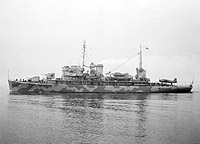 |
USS Mackinac (AVP-13)
Near the Puget Sound Navy Yard on 20 April 1942 in her original configuration. The large seaplane crane in Barnegat and Biscayne quickly proved unsatisfactory, and by late December 1941 it had been removed from Casco (AVP-12) and Mackinac (AVP-13) during the final stages of their construction. These two ships were instead completed with a semi-fixed crane, in which a long and heavy rotating boom (lowered and not visible here) was operated by machinery in a fixed deckhouse topped by a light multi-legged mast. This arrangement also proved unsatisfactory and was later replaced with a crane similar to the model introduced in Humboldt and Matagorda, below. AVP 12-13 were also completed with 20mm anti-aircraft guns on the fantail, which their large crane could not reach.
Photo No. 19-N-27318
Source: U.S. National Archives, RG-19-LCM
|
 |
USS Matagorda (AVP-22)
Photographed on 3 April 1942 at Boston, Mass. in her original configuration. Beginning with Humboldt (AVP-21) and Matagorda, units of this class were completed with a much lighter and smaller crane than the ones initially fitted in AVP 10-13. (These also soon received the lighter model.) Matagorda retained the two forward gun mounts of the original design and received a 1.1" quadruple antiaircraft mount at the after end of the superstructure and 10-20mm guns, including some on the fantail. AVP 12-13 and 21-22 were completed with this armament configuration and AVP 11 was modified to it, all in mid-1942. Matagorda is wearing Measure 12 Modified camouflage.
Photo No. 19-N-28802
Source: U.S. Naval History and Heritage Command
|
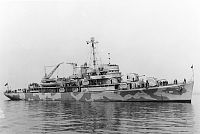 |
USS Absecon (AVP-23)
Photographed on 17 January 1943 at Houghton, Washington, on a trial run shortly before commissioning. She was specially fitted during construction with twin cranes and a catapult to serve as a training ship for battleship and cruiser aviation units, and so served throughout the war. The aircraft on the catapult is a Curtiss SO3C Seamew and the one on the fantail is a Vought OS2U Kingfisher.
Photo No. 19-N-50266
Source: U.S. Naval History and Heritage Command
|
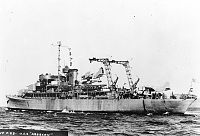 |
USS Matagorda (AVP-22)
Photographed on 27 September 1943 at Norfolk with a main armament of 4 5"/38 guns, including two open mounts aft. During the first half of 1943 five Barnegat-class ships (AVP 24-26 and 29-30) were completed with this configuration and two more (AVP 12 and 22) were modified to it. The stronger armament was intended to increase the ability of the tenders to defend themselves and their aircraft when deployed alone in the forward area.
Photo No. 19-N-51368
Source: U.S. Naval History and Heritage Command
|
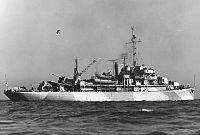 |
USS Mackinac (AVP-13)
Off the Mare Island Navy Yard on 16 September 1943 upon completion of an overhaul. She received a third 5"/38 gun on the fantail and her original 1.1" quadruple mount aft was replaced by one 40mm quadruple mount aft and two 40mm twin mounts amidships. This became the standard configuration for the class between the end of 1943 and late 1944. The first ships completed to this configuration were Onslow (AVP-48) and probably Unimak (AVP-31), both in December 1943.
Photo No. 19-N-52331
Source: U.S. Naval History and Heritage Command
|
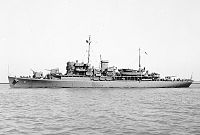 |
USS Chincoteague (AVP-24)
Photographed on 27 December 1943 off the Mare Island Navy Yard following repairs to severe battle damage incurred in July 1943. One of the four 5"/38 guns in her original armament has been replaced by a quadruple 40mm mount.
Photo No. 19-N-57482
Source: U.S. Naval History and Heritage Command
|
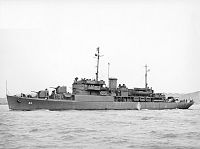 |
USS Biscayne (AVP-11)
Serving as invasion force flagship for the Anzio landings, 21-22 January 1944. Note the PT boat alongside. Her armament aft still consists of the 1.1" quadruple mount and the 20mm guns installed in mid-1942. Biscayne was fitted with flagship communications facilities in April 1943 and was belatedly reclassified AGC in October 1944.
Photo No. 80-G-223478
Source: U.S. Naval History and Heritage Command
|
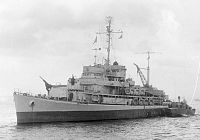 |
USS Biscayne (AVP-11)
Pierside at Arzew, Algeria, on 11 June 1944 during amphibious exercises there. USS Doran (DD-614) and a sister Gleaves-class unit are outboard. Note the superficial resemblance between the AVP and the destroyers, although the AVP lacked a fire control director and had a greater beam and shorter length than did the destroyers.
Photo No. 80-G-240881
Source: U.S. Naval History and Heritage Command
|
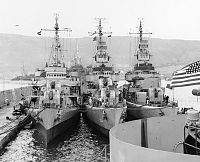 |
USS Timbalier (AVP-54)
Photographed in 1946 as originally fitted. The boom, masts, and stack of a Diver-class ARS are visible just behind her. Her main armament, a single 5"/38 gun and one quadruple 40-mm mount, both forward, became standard for the class in late 1944, reflecting the reduced threat to these ships in forward areas. The first ships completed to this configuration were Castle Rock (AVP-35) and Suisun (AVP-53) in September-October 1944.
Photo No. NH 98809
Source: U.S. Naval History and Heritage Command
|
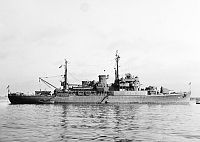 |
USS Castle Rock (AVP-35)
In Tanapag Harbor, Saipan, in April 1945, photographed from a PBM seaplane moored nearby. A large seaplane tender (AV) is behind the AVP's stern. Castle Rock is wearing weathered Measure 32, Design 2ax camouflage.
Photo No. 80-G-K-16186
Source: U.S. Naval History and Heritage Command
|
 |
USS Absecon (AVP-23)
At Pier 3, Miami, Florida, in November 1945.
This training ship has lost her starboard seaplane crane.
Photo No. None
Source: Shipscribe
|
 |
USS Corson (AVP-37)
Photographed shortly after recommissioning in 1951, with her original armament of one 5"/38 gun and one 40mm quadruple mount.
Photo No. NH 97611
Source: U.S. Naval History and Heritage Command
|
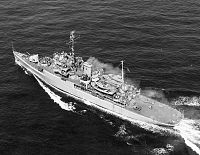 |
USS Timbalier (AVP-54)
Tending two Martin PBM Mariner seaplanes soon after World War II. The second quadruple 40mm gun mount, on the fantail, was added in around 1948. Six other ships (AVP 38-41, 53, and 55) were so modified between around 1947 and 1951.
Photo No. 80-G-483681
Source: U.S. Naval History and Heritage Command
|
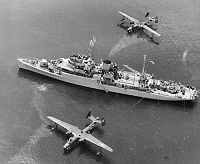 |
USS Floyds Bay (AVP-40)
Photographed with a second 40mm quadruple gun mount on the fantail. This mount was added in around 1948 and removed in around 1956.
Photo No. NH 98810
Source: U.S. Naval History and Heritage Command
|
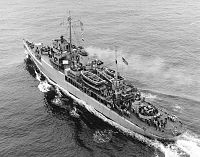 |
USS Onslow (AVP-48)
Photographed on 10 June 1952. This ship was one of four (AVP 48-49 and 51-52) that retained an unshielded 5"/38 gun mount aft after being reconfigured with the late war armament of one enclosed 5"/38 gun and one quadruple 40mm mount, both forward. Note the aviation insignia on the bow aft of the hull number.
Photo No. 80-G-444134
Source: U.S. Naval History and Heritage Command
|
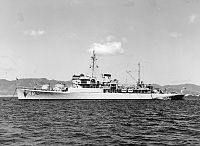 |
USS Greenwich Bay (AVP-41)
Refueling a P5M seaplane of VP-44 on 24 May 1955. She is wearing the white paint of a Middle East Force flagship. Greenwich Bay, Duxbury Bay (AVP-38), and Valcour (AVP-55) rotated as flagship of Commander, Middle East Force, from around 1950 to 1965. Greenwich Bay lost her only quadruple 40mm gun mount, located forward, in the late 1940s. The other two flagships retained this mount but instead lost their 5"/38 guns during the 1950s.
Photo No. NH 97640
Source: U.S. Naval History and Heritage Command
|
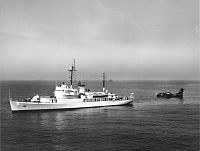 |
USS Orca (AVP-49)
Off the San Francisco Naval Shipyard on 19 December 1961 showing the ship as modified for transfer to Ethiopia. Additional superstructure has been added aft, and her armament has been reduced to a single 5"/38 gun mount forward.
Photo No. USN 1059113 (copied from an index card)
Source: U.S. Naval History and Heritage Command
|
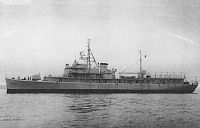 |
USS Rehoboth (AGS-50)
Photographed on 1 June 1961 off Oahu, Hawaii. Rehoboth (AVP-50) and San Pablo (AVP-30) were reclassified to surveying ships in 1949, changing their hull type designators to AGS but retaining their AVP hull numbers. Both had lost all of their guns by the end of the 1950s.
Photo No. USN 1057708
Source: Shipscribe
|
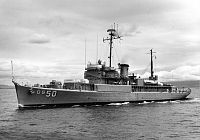 |
USS Valcour (AVP-55)
Conducting a highline transfer with USS Boston (CAG-1) on 10 May 1964. She has been heavily modified during almost 15 years of service as a flagship for Commander, Middle East Force. She was reclassified AGF-1 in 1966 to reflect this assignment and continued to serve as Middle East Force flagship until 1972.
Photo No. NH 97989
Source: U.S. Naval History and Heritage Command
|
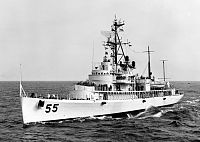 |
USNS Josiah Willard Gibbs (T-AGOR-1)
Off Fort Richmond, Staten Island, in around the early 1960s. San Carlos (AVP-51) was converted in 1958 to an oceanographic research ship and operated by a MSTS civilan crew for Columbia University's Hudson Laboratories. The deep-sea winch on her fantail was the largest and heaviest used up to that time by the U. S. for oceanographic research.
Photo No. NH 79123
Source: U.S. Naval History and Heritage Command
|
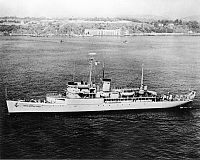 |